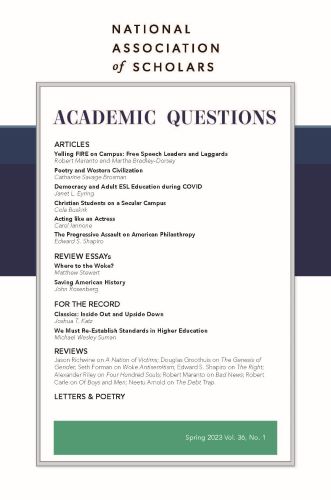The Debt Trap: How Student Loans Became a National Catastrophe, Josh Mitchell, Simon & Schuster, 2022, pp. 272, $17.99 softcover.
Neetu Arnold is Senior Research Associate at the National Association of Scholars; [email protected]. She is the author of the NAS report Priced Out: What College Costs America (2021), a detailed analysis of the spending habits of fifty universities. Arnold appeared in our fall 2022 issue with “The Role of Government in the Student Debt Crisis,” a review of Indentured Students: How Government Guaranteed Loans Left Generations Drowning in College Debt (Harvard 2022).
In the wake of the Biden administration’s major attempt at student debt forgiveness, Josh Mitchell’s The Debt Trap provides a useful historical overview of the monster that is our current student lending system. Through chronological vignettes of the historical context surrounding important policy changes, he describes the “perverse incentives for lenders, schools, and borrowers” that led to the current $1.7 trillion in student debt, as well as rapidly rising tuition prices. While his account acknowledges the sometimes accidental nature of the student lending system, it also demonstrates that a mistaken ideology of “college for all,” along with government corruption, was the primary source of the debt crisis.
Mitchell begins his story with the passage of the National Defense in Education Act (NDEA) in the 1950s. This was the government’s first foray into issuing student loans, and it was a limited one—the loans would help a small number of American students studying foreign languages, math, and science. The story behind the bill is an instructive one: the goals for the politicians who penned the bill derived from the “college for all” ideals of the earlier Truman Commission. But these politicians had to use national defense to sell the bill to Republican colleagues, who were reluctant to give the government more power over education. And like other putatively small, temporary programs in the same bill,1 the government only needed to get its foot in the door before the student lending industry became permanent and ever-expanding.
The first major expansion was only a few years down the road with the passage of the Higher Education Act (HEA) in 1965. The backstory Mitchell provides for this significant bill adeptly combines ideological fervor with historical accident. First, the ideology: Lyndon B. Johnson was an avowed “college for all” advocate. He drew from his working-class background and experiences as a schoolteacher where he concluded that education was the best way to lift Americans out of poverty. So, when the opportunity came, Johnson was ready to fund college education for the masses by whatever means necessary.
But a deficit-heavy budget (due to Johnson’s massive spending on Great Society social programs) forced him to find a cheaper way to fund college—at least on paper. Johnson turned to banks to issue government-guaranteed loans. This meant that the loans themselves wouldn’t appear on the government’s balance sheet, which would make the program appear almost costless.
The problems with this system appeared almost immediately. Rising inflation forced banks to increase interest rates on the loans, which priced out many potential borrowers. Colleges rapidly increased their tuition due to the improved ability of potential students to pay. A frustrated Johnson demanded that the banks and schools rein in their price increases, but quickly discovered that he had very little power to enforce those demands. So, deeming this project insufficient, he brought in Alice Rivlin to hatch a new plan.
A noted economist and budget whiz, Rivlin came up with the blueprint for Sallie Mae: a government-sponsored enterprise, similar to earlier home lending programs, which would service government-backed student loans. Congress officially created Sallie Mae in 1972, beginning its long era of dominating student loan policy. While Sallie Mae did not initially issue student loans itself, it worked with banks to improve their cash flow and it made sure that the loan accounting was off the government books. With the lending system at least indirectly under federal control, politicians were able to achieve their goals of keeping interest rates relatively low and rapidly expanding the number of loans.
Here, Mitchell’s story shifts somewhat from focusing on ideology as the main driver of decisions to a narrative of corruption and entrenched government bureaucracy. He tells a tale of not-so-secret personal relationships between politicians and higher education lobbyists, of rent-seeking by Sallie Mae and the student loan industry, and of inexorably expansive bureaucracy beyond the reach of even the most austere Reagan administration appointees. Along the way, he uncovers the insatiable greed of the universities, which were only too happy to prey upon the emotions of voters and politicians to secure more revenue for themselves. Mitchell aptly points out the unique corruption of the for-profit colleges and the Historically Black Colleges and Universities (HBCU), which often offered particularly poor-quality educational programs for high prices, hiding behind the façade of “opportunity” to obtain government subsidies.
But throughout these important historical accounts, Mitchell glosses over a crucial debate: that of merit versus need. Elizabeth Tandy Shermer’s similar work, Indentured Students (2021), devotes a significant amount of time to this issue, if only to not-so-subtly insinuate that the proponents of merit over need were racists.2 Mitchell’s story misses characters such as Oregon Congresswoman Edith Green, an advocate for merit-based government aid that would have made college more affordable for academically qualified poor and middle-class students. Without foils to the “college for all” proponents like Green, the conflicts in Mitchell’s account are unidimensional—they only deal with the extent of lending, not the nuances of loan distribution and access. Unfortunately, this omission results in an unsatisfying ending to his tale along with policy solutions that broadly fail to address the underlying issues he elucidates throughout the book.
Mitchell concludes with a chapter titled “The Trap,” where he lays out what he believes to be the two main problems with student lending today: 1) students pay back more than they borrowed due to high interest rates, and 2) student loans are unable to be discharged through bankruptcy. He combines his diagnosis with a heart-wrenching tale of “Lisa,” a single mother Ph.D. who borrowed more than one-hundred thousand dollars in student loans and suffered repeated financial and personal hardships over the years as she struggled to repay her loans.
But Mitchell’s interest rate “trap” should feel strangely unconvincing to anyone who’s borrowed money for a purchase or investment. Interest rates exist for just about every loan. Yet, we don’t hear people call mortgages or business loans traps. The lack of bankruptcy as a policy failure is a more compelling argument. But if that is the only problem with student loans, what is the purpose of the entire story of greedy colleges and government bureaucracy? The dysfunction in the student lending system is in fact much deeper, as even Mitchell’s hand-picked story of Lisa demonstrates. Lisa’s problem can be summed up simply: she is an individual who had a predictably low return on investment from her expensive graduate degree, and a sensible student lending system would likely have significantly restricted her loan amount. She used her degree to work as a therapist for a salary of seventy-thousand dollars a year, hardly worth the massive debt the required education cost her. All the other issues—interest rates, no escape through bankruptcy—are secondary, and her tragic situation derives from that first poor decision.
Mitchell’s story fails to sufficiently address the vast heterogeneity among borrowers, colleges, and degree programs within colleges. This has everything to do with the merit versus need debate that Mitchell glosses over. Many students still benefit from the student lending program in spite of high tuition costs and interest rates on loans. That’s because these students are academically qualified and they enter schools and programs with high return on investment. Cases like Lisa’s are outliers—most students do not borrow nearly the amount she did, and most borrowers who struggle with their loans actually owe much less than she. Struggling borrowers are often college dropouts or graduates of expensive and poor-quality colleges, whose lack of financial success post-college could have been easily predicted by their program of choice and their previous academic performance.
It should come as no surprise that Mitchell’s proposed solutions at the end of his book are unsatisfying. Forgiving student loan interest will encourage more borrowing, particularly from the most unqualified and risky borrowers. His suggestions to make community college free but end grad school lending miss important distinctions between profitable and unprofitable programs, which are present in both community colleges and grad schools.
A more sensible policy would focus on objective measures of a degree’s economic returns. Furthermore, the government would lend strategically to programs that are profitable for students, regardless of whether they attend a community college or an Ivy League grad school. Allowing students to discharge student loans through bankruptcy is sensible, provided reasonable restrictions are in place. Requiring colleges to bear some of the cost of defaults, or “skin in the game,” is a better suggestion that would do some good. But it would be less potent compared to simply restricting lending at the source: the federal government.
Mitchell’s book provides important historical context on the federal student lending system. He astutely identifies the mistake lawmakers made in assuming that indefinite loan expansion would benefit students. But he sidesteps the crucial debate of merit versus need in student aid. By failing to sufficiently address this important dimension of the conversation, his policy proposals miss the mark—and they may even create perverse incentives of their own. In order to curb waste and restore efficiency to the federal student lending system, academic merit must be just as central as credit scores are in other lending markets.
1 See Neetu Arnold, “A Cold War Program Gets Hijacked,” Wall Street Journal, October 9, 2022.
2 See Neetu Arnold, “The Role of Government in the Student Debt Crisis,” Academic Questions 35, no. 3 (Fall 2022).
Photo by zimmytws on Adobe Stock













